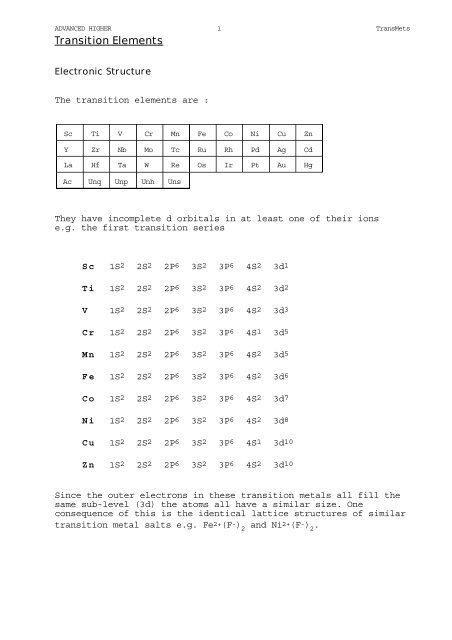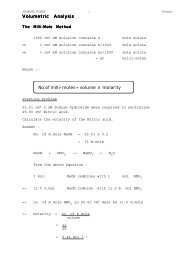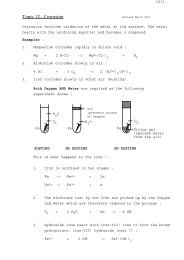Transition Metals - Iandalgleish.co.uk
Transition Metals - Iandalgleish.co.uk
Transition Metals - Iandalgleish.co.uk
You also want an ePaper? Increase the reach of your titles
YUMPU automatically turns print PDFs into web optimized ePapers that Google loves.
ADVANCED HIGHER 1 TransMets<strong>Transition</strong> ElementsElectronic StructureThe transition elements are :Sc Ti V Cr Mn Fe Co Ni Cu ZnY Zr Nb Mo Tc Ru Rh Pd Ag CdLa Hf Ta W Re Os Ir Pt Au HgAc Unq Unp Unh UnsThey have in<strong>co</strong>mplete d orbitals in at least one of their ionse.g. the first transition seriesSc 1S2 2S2 2P6 3S2 3P6 4S2 3d1Ti 1S2 2S2 2P6 3S2 3P6 4S2 3d2V 1S2 2S2 2P6 3S2 3P6 4S2 3d3Cr 1S2 2S2 2P6 3S2 3P6 4S1 3d5Mn 1S2 2S2 2P6 3S2 3P6 4S2 3d5Fe 1S2 2S2 2P6 3S2 3P6 4S2 3d6Co 1S2 2S2 2P6 3S2 3P6 4S2 3d7Ni 1S2 2S2 2P6 3S2 3P6 4S2 3d8Cu 1S2 2S2 2P6 3S2 3P6 4S1 3d10Zn 1S2 2S2 2P6 3S2 3P6 4S2 3d10Since the outer electrons in these transition metals all fill thesame sub-level (3d) the atoms all have a similar size. One<strong>co</strong>nsequence of this is the identical lattice structures of similartransition metal salts e.g. Fe2+(F-) 2and Ni2+(F-) 2.
ADVANCED HIGHER 2 TransMetsThe vacant d orbitals are the reason that many transition metalsare heterogeneous catalystse.g. Iron catalyses the Haber process :3H 2 + N 2 -> 2NH 3When the H 2 and N 2 be<strong>co</strong>me adsorbed on the catalyst surfaceelectrons flow out of the H-H and N N bonds into the vacant dorbitals on the Iron atoms. Thus the H-H and N N bonds areweakened lowering the activation energy.NNHHFeFeThe energies of the 3d and 4S orbitals are very similar. It is afact that electrons in a d orbital repel each other more thanelectrons in an S orbital. In a neutral atom the electrons in the3d orbital are therefore further from the nucleus (higher energy)than the electrons in the 4S orbital. When electrons are removedfrom the atom to form an ion the electron-electron repulsions arereduced and the 3d orbital actually falls below the 4S orbital inenergy.Electrons are, in effect, removed from the 4S orbitalbefore the 3d orbitals.e.g. the formation of the Mn2+ ion3d4S4S3dMn Mn 2+Mn (4S2 3d5) -> Mn2+ (4S0 3d5)The 2+ valency (oxidation state) is therefore the most <strong>co</strong>mmon intransition elements but, because of the close proximity of the 3dorbitals, the third ionisation energy is low, resulting in theeasy removal of a third electron :Mn2+ (4S0 3d5) -> Mn3+ (4S0 3d4)
ADVANCED HIGHER 3 TransMetsIons with charges greater than 4+ are unknown. The energy requiredto pull 4 electrons <strong>co</strong>mpletely off an atom is just too great.Subsequent electrons can however be released from the d orbitalsto form polar <strong>co</strong>valent bonds resulting in many <strong>co</strong>mpounds andions in which Manganese, like all the transition metals, exhibitsa variable valency:e.g. manganate(VII) ion MnO 4-An electrovalent structure for this ion would be impossible. Thehighly positive Mn7+ ion would attract electrons from the O2- ionsresulting in the formation of <strong>co</strong>valent bonds between Mn and O :O 2- O 2-O-O 2-Mn 7+O 2-OMnOOThe electrovalent model is nevertheless useful : we can imaginethe Mn7+ ion protected by a cage of O2- ions. Take away theprotection and you have a highly effective oxidising agent, Mn7+.e.g. Oxidation of chloride by acidified manganate(VII) :MnO 4- + H+ + Cl- -> Mn2+ + H 2 O + Cl 2The oxidation state of Mn decreases from 7 to 2 as it is reducedin this reaction.Manganese exhibits the greatest variety of oxidation states of allthe transition metals :Oxidation state Examples2 Mn2+, MnCl 2- 43 Mn3+4 MnO 2 , MnCl 2- 65 MnO 3- 46 MnO 2- 47 MnO 4-, MnO + 3
ADVANCED HIGHER 4 TransMetsThe variable valencies of transition metals allows them to act ashomogeneous catalysts in redox reactions e.g. both Fe2+ and Fe3+catalyse the reaction :slowS 2 O 2- 8 + 2I- -> 2SO 2- 4 + I 2Mechanism with Fe2+ catalyst :fastS 2 O 2- 8 + 2Fe2+ -> 2SO 2- 4 + 2Fe3+fast2I- + 2Fe3+ -> I 2 + 2Fe2+Mechanism with Fe3+ catalyst :fast2I- + 2Fe3+ -> I 2 + 2Fe2+fastS 2 O 2- 8 + 2Fe2+ -> 2SO 2- 4 + 2Fe3+
ADVANCED HIGHER 5 TransMetsComplex IonsThe vacant d orbitals in a transition metal ion leaves it open toattack by ligands - negative ions or neutral molecules with lonepairs. The ligand forms a bond to the metal ion by donating itslone pair into an empty d orbital e.g. reaction of Water withCu2+ :HHO Cu 2+Six Water ligands may be<strong>co</strong>me attached to the Cu2+ ion forming theblue hexaaqua<strong>co</strong>pper(II) ion which has an octahedral shape :HHHHOHOO Cu 2+H OHOHHHHOHThe number of ligands grouped around the metal ion is known as theion's <strong>co</strong>ordination number - 6 in this case.Similarly Ammonia can behave as a ligand : When a solution ofAmmonia in Water is added to a solution of Copper(II) sulphate inWater the Water ligands are displaced by the Ammonia and a deepblue solution <strong>co</strong>ntaining the tetraamminediaqua<strong>co</strong>pper(II) ion isformed :4NH 3 + Cu2+(H 2 O) 6 -> 4H 2 O + Cu2+(NH 3 ) 4 (H 2 O) 2HHHNHHNHHHHHO HN HCu 2+ NOHHHHBoth H 2O and NH 3are monodentate ligands - they have only onedonor site.
ADVANCED HIGHER 6 TransMets1,2-Diaminoethane is a bidentate ligand with two donor sites e.g.NHHCH 2CH 2H HNHHCH 2CH 2NNi 2+N Tri 1,2-diaminoethane nickel(II)HHNHHH 2CNHH 2CHIn octahedral <strong>co</strong>mplexes like the hexaaqua<strong>co</strong>pper(II) ion theligands approach the central metal ion along the x, y and z axesrepelling electrons in the d x 2 -y 2 and d z2 orbitals which liedirectly along the x, y and z axes. Thus the energies of thed x 2 -y 2 and d z 2 orbitals are increased relative to the d xy , d yz andd xz orbitals which lie between the x, y and z axes :d x 2- y 2d z 2∆dxydxzdyzIn Cu2+(H 2 O) 6 ∆ = 2.6 x 10-19 kJ. This <strong>co</strong>rresponds to a wavelengthof 764 nm (red light). When red light of wavelength 764 nm strikesthe Cu2+(H 2 O) 6 ion an electron in the lower levels (d xy , d yz andd xz ) is promoted into the higher levels (d x 2 -y 2 and d z2) and redlight is absorbed ; all other <strong>co</strong>lours are transmitted. We candeduce the resulting <strong>co</strong>lour (cyan) using the <strong>co</strong>lour triangle :RYMGCB
ADVANCED HIGHER 7 TransMetsUltra Violet and Visible Spectros<strong>co</strong>pyAn Ultra violet/Visible spectrometer can be used to measure thewavelength and intensity of the light absorbed:100200 - 400 nm UV400 - 800 nm VIS% transmittance500200 400 600 800λ/nmvariable wavelengthUV/VIS sourcesample incuvettephotocellscreen display ofspectrumAs the wavelength is increased from 200 nm the instrument measuresthe intensity of the light passing through the sample and hittingthe photocell detector. The percentage of the light transmittedthrough the sample is re<strong>co</strong>rded. When no absorption occurs the %transmittance is close to 100%.A solution <strong>co</strong>ntaining hexaaqua<strong>co</strong>pper(II) ions would absorb at764 nm. When the variable wavelength source reaches 764 nm thesolution would absorb some of the light causing a drop in the %transmittance. The more light absorbed the lower the %transmittance and the bigger the peak. The amount of lightabsorbed depends on the <strong>co</strong>ncentration of the solution and cantherefore be used to measure solution <strong>co</strong>ncentration.
ADVANCED HIGHER 8 TransMetsThe Spectrochemical SeriesThe ligand field splitting energy, ∆, depends on the power of theligand to squeeze the electrons in the d x 2 -y 2 and d z2 orbitals. Thespectrochemical series lists the ligands in order of increasedsplitting power:CN- > NH 3 > H 2 O! Compare the blue hexaaquachromium(III) and the magentahexaamminechromium(III) ions :Cr(H O) 3+2 6Cr(NH ) 3+3 6yellowgreenRRYMYMGCBGCBYellow light absorbedBlue light transmittedGreen light absorbedMagenta light transmitted! The hexaaquairon(II) ion <strong>co</strong>ntains unpaired electrons ; thehexacyanoiron(II) ion does not :Fe(H O) 2+2 6Fe(CN ) 4-6∆ is so great in the hexacyanoiron(II) ion that it is morefavourable for electrons to pair up and share orbitals thanjump up into the higher energy levels.




